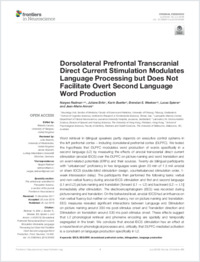Dorsolateral prefrontal transcranial direct current stimulation modulates language processing but does not facilitate overt second language word production
- Radman, Narges Neurology Unit, Section of Medicine, Faculty of Science and Medicine, University of Fribourg, Switzerland - School of Cognitive Sciences, Institute for Research in Fundamental Sciences, Tehran, Iran
- Britz, Juliane Neurology Unit, Section of Medicine, Faculty of Science and Medicine, University of Fribourg, Switzerland
- Buetler, Karin Leenaards Memory Center, Department of Clinical Neuroscience, Lausanne University Hospital, Lausanne, Switzerland
- Weekes, Brendan S. Laboratory for Communication Science, Division of Speech and Hearing Sciences, The University of Hong Kong, Pokfulam, Hong Kong - School of Psychological Sciences, Faculty of Dentistry, Medicine and Health Sciences, The University of Melbourne, Australia
- Spierer, Lucas Neurology Unit, Section of Medicine, Faculty of Science and Medicine, University of Fribourg, Switzerland
- Annoni, Jean-Marie Neurology Unit, Section of Medicine, Faculty of Science and Medicine, University of Fribourg, Switzerland
-
2018
Published in:
- Frontiers in Neuroscience. - 2018, vol. 12, p. 490
English
Word retrieval in bilingual speakers partly depends on executive-control systems in the left prefrontal cortex - including dorsolateral prefrontal cortex (DLPFC). We tested the hypothesis that DLPFC modulates word production of words specifically in a second language (L2) by measuring the effects of anodal transcranial direct current stimulation (anodal-tDCS) over the DLPFC on picture naming and word translation and on Event Related Potentials (ERPs) and their sources. Twenty-six bilingual participants with ‘unbalanced’ proficiency in two languages were given 20 minutes of 1.5mA anodal or sham tDCS (double-blind stimulation design, counterbalanced stimulation order, one-week intersession delay). The participants then performed the following tasks: verbal and non-verbal fluency during anodal t-DCS stimulation and first and second language (L1 and L2) picture naming and translation (forward (L1→L2) and backward (L2→L1)) immediately after stimulation. The EEG was recorded during picture naming and translation. On the behavioral level, anodal-tDCS had an influence on non-verbal fluency but neither on verbal fluency, nor on picture naming and translation. EEG measures revealed significant interactions between Language and Stimulation on picture naming around 380 ms post stimulus onset and Translation direction and Stimulation on translation around 530 ms post stimulus onset. These effects suggest that L2 phonological retrieval and phoneme encoding are spatially and temporally segregated in the brain. We conclude that anodal-tDCS stimulation has an effect at a neural level on phonological processes and, critically, that DLPFC-mediated activation is a constraint on language production specifically in L2.
- Faculty
- Faculté des sciences et de médecine, Faculté des lettres et des sciences humaines
- Department
- Médecine 3ème année, Département de Psychologie
- Language
-
- English
- Classification
- Biological sciences
- License
-
License undefined
- Identifiers
-
- RERO DOC 322920
- DOI 10.3389/fnins.2018.00490
- Persistent URL
- https://folia.unifr.ch/unifr/documents/307132
Statistics
Document views: 148
File downloads:
- pdf: 209
